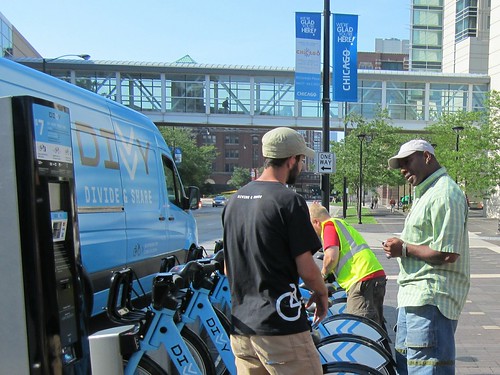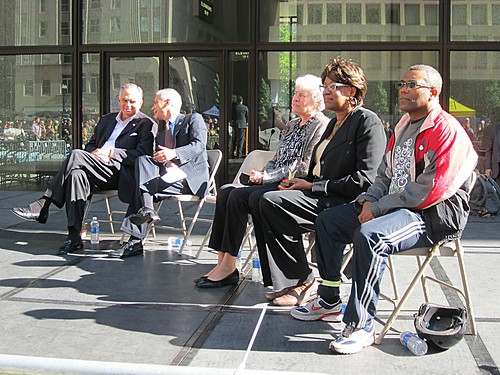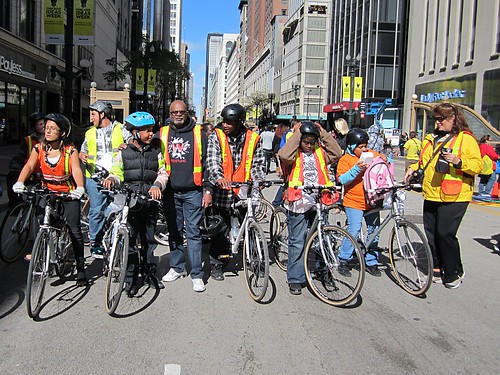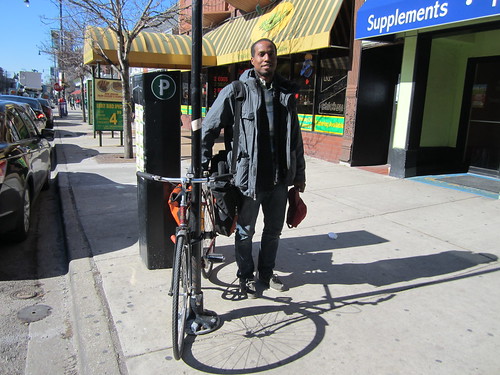Last month I talked to Scott Kubly, deputy commissioner of the Chicago Department of Transportation, about the city’s efforts to make sure the new Divvy bike-share system benefits all Chicagoans, including those in low-income neighborhoods and/or communities of color. Surveys in bike-share cities like Washington, D.C., and Denver have shown that use of their publicly-funded systems has been skewed towards a disproportionately white, affluent demographic. Kubly says CDOT is committed to making sure Divvy ridership better reflects our city’s ethnic and economic diversity.
We discussed the new system’s planned coverage area, which spans from Devon Street to 63rd but generally stays within a few miles of the lake, and station density, which is higher in more populated, retail-rich areas, mostly on the North Side. Kubly said physical barriers like expressways, rail lines and industrial zones provide challenges to creating a coherent South Side network, but noted that CDOT has already applied for additional funding to expand the system into many more neighborhoods. He also talked about plans to partner with community organizations to make bike-share memberships available to unbanked residents, as well as job-training program that has provided about 20 percent of the Divvy workforce, and a youth apprenticeship program for 600 teens.
I shared Kubly’s remarks with several aldermen and bike advocates from the South and West sides and asked for their thoughts on whether Divvy is being implemented in an equitable manner. “I think CDOT and Alta [the bike-share contractor] are being very fair about it,” said 27th Ward Alderman Walter Burnett, whose West Side district includes parts of low-income communities like East Garfield Park, Humboldt Park and Cabrini Green. “But it may take longer for bike-share to catch on in poor neighborhoods. For example, Zipcar [car sharing] is not used as much on the South Side or the West Side. It takes time for people to get accustomed to new things. Eventually they will see the bikes and see how successful the program is and they’ll start using it.” He added that he appreciates that Divvy is creating jobs opportunities for young people, and that the system’s Goose Island assembly and maintenance facility is located in his ward.
Jane Healy, an Active Transportation Alliance board member who leads youth cycling programs in the blue-collar south suburb of Blue Island, is a bit more skeptical. “Because I'm on the board of Active Trans, I saw some early information that showed a preponderance of stations on the Near North Side and the central business district,” she wrote me. “When I questioned that, I was told basically the same things as what you pointed out in your article, about population and business density, physical barriers, etc.”
“I encouraged everyone I knew on the South Side who's a bike rider to vote on station locations when Alta was soliciting for that input,” she wrote. “But even that process is suspect. While I bet most people on the Near North Side are tech savvy and plugged in, I'm not willing to make that assumption for the South and West sides of the city. Not only might the cost of membership be a barrier, the challenges of communicating about the program with potential customers in lower economic communities is a hurdle. How many people in less affluent areas work second or third shifts? How many work more than one job? Can they make it to community meetings that are generally held on evenings? … I'm quite sure that advocacy is a pretty low priority for someone with limited disposable income.”
“I also see the half-mile between docking stations on the South Side as a pretty big barrier,” she added. “When I was in Boston last year, part of what made their bike-share program so amazing was that there were stations everywhere. If you want people to make a significant change in mode share, it HAS to be easy or it won't happen.”
“[CDOT’s efforts are] a good start but there’s a long way to go before they have ‘cracked the challenge,’ to paraphrase Mr. Kubly,” Healy said. “I'm grateful that they are at least thinking about it.” She recommended that the department make a strong push to promote the service in various neighborhoods, including outreach in multiple languages.
Erin Allen, a Pilsen resident and social services case worker who largely commutes by bike, responded to a request for feedback I sent to members of the African-American cycling group Red Bike and Green. “I love the idea of job creation and skill development,” she wrote. “I love the attention to youth and to the program being affordable. In fact, I love the attention to everything [Kubly described] in this article, even potential endeavors like other ways of paying besides a credit card, and expanding it further west.”
“I wonder what else can be done to sell low-income and [people of color] communities on biking, in general,” she added. “Population density is one thing to consider when deciding where to place stations, but ideology is also important. Although biking - instead of walking, driving, or not going at all - seems like the most reasonable option in some cases, people whom I encounter in these communities would much rather drive. This is true although they might not have a car. Driving reflects the lifestyle that is valuable to most people, not just low-income and [people of color] communities.”
“As a black woman biking occasionally down King Drive, I feel all alone,” Allen said. “Sometimes people actually point at me when I ride by. The sight of me may be striking because people don't have access to a bike, an issue that Divvy aims to alleviate, at least for short trips around the ‘hood, as far as I understand. But it's probably also because using a bike to run errands or attend an event is just not at the forefront people's minds… I wonder if partnering with community organizations can address that.”
Dustin Gourdin, a University of Chicago grad student who also rides with Red Bike and Green and has done work with community bike shops in Southern Africa and on Chicago’s South Side, has used bike-share in D.C. and Denver. He said there may be significant hurdles to using Divvy for low-income residents.
“When you’re riding a bus, the barriers of entry are rather low and the learning curve is pretty mild,” he wrote. “Navigating a bike-share program can be a different experience. First, the requirement for a credit card has to be tackled. After successfully checking out a bicycle, the user is left to more or less fend for himself or herself. The rider is expected to plan a route, operate the bicycle, negotiate traffic and budget time. Some people may relish this autonomy. Others may fear the uncertainty.”
“This is all assuming that the users are healthy enough for cycling in the first place,” he added. “Bicycle infrastructure and safety considerations should also be assessed and improved as necessary. Adult how-to-ride classes should be used not only to teach, but to entice community members to bike. Bicycle-sharing, especially in low-income communities, cannot be simply building stations and handing out passes.”
“All-in-all, I believe the Divvy program could be a huge step for transportation infrastructure and mobility in low-income communities,” Gourdin concluded. “The program just needs to carefully consider the factors that make cycling a safe, popular and attractive alternative in other parts of the city and reproduce them in communities that are anticipated to be low-use.”
After this article was published, I received the following statement from 25th Ward Alderman Danny Solis, who's Near South district includes parts of several low-income communities:
I am very excited about Divvy's new bike-share program, especially the locations that have been installed in my ward and in Pilsen. The 25th Ward is a diverse community that will be well served by this new opportunity to bicycle. But this is just the first installment of Divvy bike-share stations with many more to come in the future that will continue to distribute out across the city to serve more residents in more and more neighborhoods.







